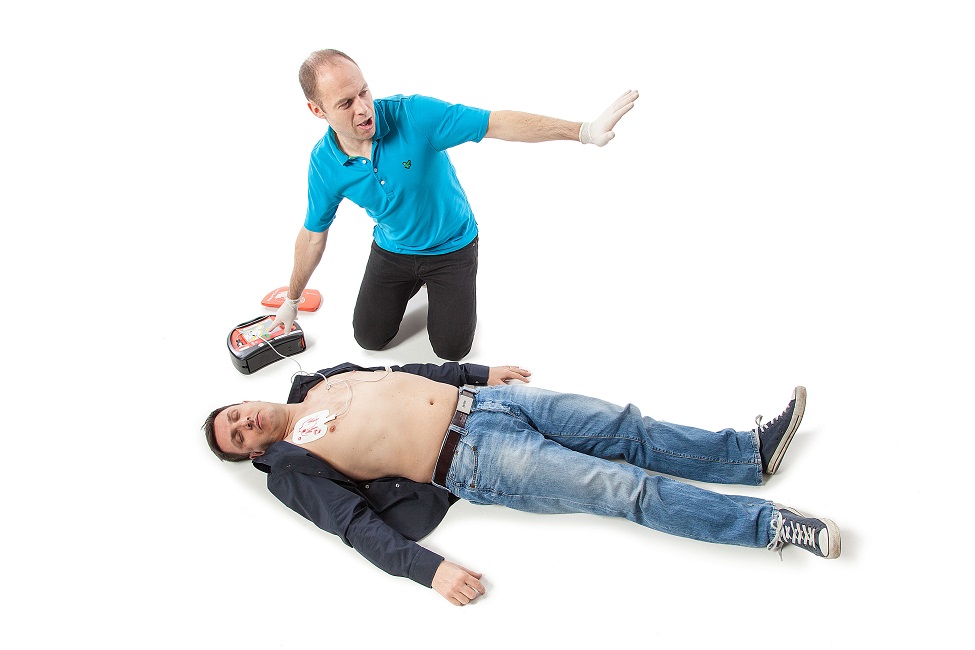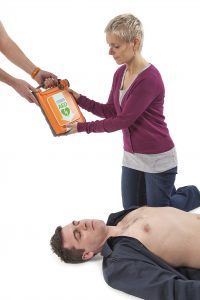Many people have outdated ideas about what defibrillators are, what they do, and how they are used. When the word is mentioned, they may picture a hospital, a trained doctor or a nurse giving a patient a shock from a large, intimidating machine with two metal pedals that administer a massive shock that dramatically brings the patient back to life.
Thanks to TV shows and glitzy Hollywood films, defibrillators have been seen as a mysterious life-saving machine that can also be dangerous and complicated, however, the truth is very different.
There is a type of defibrillator called an Automated External Defibrillator (AED). An AED is a small device that analyses a person’s heart rhythm in order to detect the irregularity that occurs during a Sudden Cardiac Arrest (SCA). They then administer a shock to the victim to get their heart back into a normal rhythm.
AED’s are incredible machines that are completely user-friendly and can save the life of a person suffering from a SCA, but there tends to be confusion and mystery surrounding them. We’ve taken a look at the biggest myths about defibrillators, and why believing them could lead to fatality.
- I can’t use a defibrillator, I’ve not been medically trained and it’s too complicated
This is one of the most common myths surrounding AED’s. For many people, the only exposure they will have had to a defibrillator in use will have been on TV, with a medical professional handling the equipment. Contrary to this image, AED’s are in fact very simple to use.
Anyone can use an AED, even if they’ve not had formal training. They are safe to use by people of all ages, and many have voice-guided systems or step-by-step directions coupled with pictures to aid the user. They have been designed to be completely user-friendly – you should never worry about breaking one or be apprehensive about following the instructions.
- I could seriously hurt someone if I use a defibrillator on them
A major myth is that using an AED on someone incorrectly may harm them. This is understandable – the thought of giving someone’s heart an electric shock sounds like a frightening and invasive procedure.
What you need to remember is that that all AED’s have a built in failsafe to ensure that they won’t shock someone who is not suffering from a SCA. When an AED needs to be used, the patient will technically be already dead, so there is no possible way to cause them any further damage. Never worry about causing someone further harm when performing CPR or using a defibrillator on them, because, put bluntly, the alternative is death.
As well as this, a AED will never deliver a shock to a person whose heart is not in irregular rhythm, as we will discuss in more detail below.
- A defib could be harmful to me if I don’t use if properly
If you’ve not had any experience using an AED before, they can seem quite intimidating. It’s natural to be worries about your own safety, especially
in high-pressured and dangerous situations. We can tell you that an AED cannot shock a person who’s heart is in normal rhythm no matter which side of the pads you are on.When you apply the pads to a patient and the AED analyses their heart rhythm, you will be told not to touch the patient before the shock is administered. If you are touching the patient, the most you will feel is a slight twinge.
- A defib is a life-saving device that can be used on anyone who has been injured
This is untrue. Unfortunately, defibrillators can only aid people who have suffered from a Sudden Cardiac Arrest.
Although it is important to remember that there are approximately 30,000 out of hospital cardiac arrests per year in the UK and an AED will never shock a person who is not suffering from a SCA. This means it’s well worth understanding and making yourself familiar with AEDs to ensure that you are prepared and informed should you be in the vicinity of one occurring.
- I don’t need to use a defib on this person as I’ve called an ambulance and it will arrive soon
In an emergency situation where you suspect that a person has had a SCA, you must first call the emergency services. After this, unless instructed otherwise you should look for an AED in order to use it.
If a defibrillator is used and effective CPR is performed within 3-5 minutes of cardiac arrest, survival chances increase from 6% to 74%. Considering that the emergency services average response time to an urban cardiac incident has recently increased from 8 to 11 minutes, every single second counts.
Always be prepared to take action
The reality of a SCA is that without immediate treatment, 90-95% of Sudden Cardiac Arrest victims will die. This is why it’s so important for everyone to understand how effective AEDs are, and how simple they are to use.
Rosa Mitchell is a guest writer for defibshop, the UK’s independent defibrillator supplier. For more information about defibrillator myths, take a look at their infographic.

